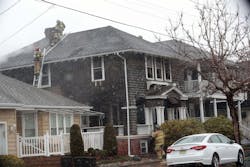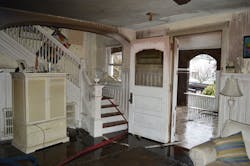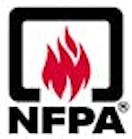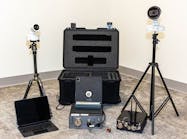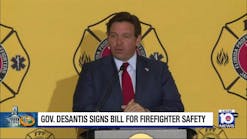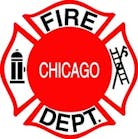As we have all discovered in our own ways, a simple distraction can lead to problems. It takes significant discipline—through training—to ensure we don’t get it wrong. This month’s Close Call could happen to any of us, and that's why we share these events—so we can learn.
About the department
Margate City, NJ, is on Absecon Island, which stretches for 8.1 miles, and is also home of Atlantic City and Ventnor City to the northeast, and Longport on the southwest. The city stretches about eight blocks from the Atlantic Ocean to the bay at most points in town.
The Margate City Fire Department (MCFD) is staffed by 35 firefighters working four shifts, with eight firefighters assigned to each shift, with a minimum staffing level of six on-duty personnel. The on-duty crew staffs one engine, one quint and two ambulances, and responds to approximately 800 fire and 1,100–1,200 EMS runs annually. The MCFD is part of an automatic mutual-aid response system with Longport, Ventnor City and Ocean City.
The incident
The Q-24 crew placed several ladders in position for additional means of egress for firefighters working inside and exterior ventilation. Once ladders were in place, Firefighters David Funk and Christopher Graves were tasked with venting a window on the A side, division 2. Note: During this task, Funk was utilizing his SCBA on air; however, he initially had an issue with the bypass valve on his mask being opened and his ambient air valve being closed. He corrected this problem immediately.
While Funk and Graves were venting, Captain Patrick Armstrong and Firefighter Cameron Fickling-Rone noticed a VCFD member—Captain Kyle Smith—at a division 1 window who was out of air and required immediate assistance. Smith had called an out-of-air emergency mayday but it was never heard due to a radio system failure.
Armstrong, Rone and a VCFD firefighter took out the window, allowing Smith access to clean air. The RIT crew of Armstrong, Funk, Graves, Rone and Kirk Battles prepared to make entry to assist Smith, but just prior to entry, Smith was seen exiting the building. At this time, VCFD Deputy Chief Brady Middlesworth requested Q-24 crew take a handline to the second floor to extinguish any fire encountered.
Once on division 2, the Q-24 crew encountered heat and heavy smoke, but they were able to locate and knock down the fire in their area. Funk served as nozzle firefighter on the attack line. After doing so, several calls for ventilation were attempted. These calls were unheard, again, due to radio system failure. MCFD Chief Dan Adams reported hearing one of requests for ventilation and advised fire command of the same. Command then assigned a VCFD crew to ventilate the roof.
Funk informed Armstrong that he was going off the handline to locate a window in their immediate area to make an attempt to ventilate. With no quick success, Funk returned to his position. According to Funk’s recount of the incident, it was at this time that he noticed his SCBA heads-up display (HUD) went from three lights to two, indicating that his air supply was now at half cylinder. He informed Armstrong at this time. Moments after, the light changed upon inhalation, and Funk had no air, despite two lights still showing. He attempted to make some adjustments but had no success, so he started making his way to the stairway while attempting to notify personnel in his path of his situation.
Funk then dove down the stairs, made his way outside and, with the help of Graves and some VCFD personnel, removed his helmet, SCBA and coat. Due to his inhalation of smoke, Funk was transported to the hospital for evaluation by VCFD Ambulance 1.
Post-incident review, investigation and findings
Funk has been a firefighter with MCFD since May 2004. Prior to that, he was a member of nearby Longport Volunteer Fire Department from 2000 to 2010 and was a lieutenant there from 2003 to 2008.
Throughout his career, Funk has taken numerous classes and received numerous certifications. In addition, the shift he is on with the MCFD has performed numerous SCBA drills, including donning, buddy-breathing, and RIT pack SCBA. Funk is someone the MCFD identifies as an experienced firefighter.
The investigation into the events that transpired during this call involved reading the fire report and individual statements from on-scene personnel. Adams ordered Lt. Eric Grace to perform testing on Funk’s SCBA mask, which had been sealed since the incident. Grace found that his mask passed all tests and was in working condition.
Another part of the investigation involved Funk re-enacting the events leading up to the incident. This included opening the cylinder valve and stopping to address the air flowing from the mask. Funk addressed the issue, but he does not remember continuing to open the cylinder valve completely. He donned the mask, breathing normally, and shut the cylinder valve, thus depleting the system of air while watching the HUD lights react by going out. Funk then repeated this again while breathing heavily, which quickly depleted the SCBA system of air. However, the lights stayed on, which is easily explained, as the breathing air compressor (BAC)/HUD combination on this model SCBA refreshes at 10-second intervals.
The final conclusion: When Funk cracked open his bottle valve, the bypass valve was opened and the ambient air valve closed. He addressed it by closing the bypass valve and went to work venting the windows. He was then assigned to fire attack without going back to fully open his bottle valve. This left his bottle only opened a quarter turn. When performing the interior fire attack, his bottle must have bumped into something, closing the bottle valve. As a result, Funk’s air supply was cut off. This analysis was confirmed by Funk’s statements about the incident.
Additional comments
The following are comments from Chief Adams, Chief Goldfeder and others involved in the incident safety investigation review.
The conditions and events at this fire scene leading up to this incident—frequent communication system failure, weather, mayday at window, and RIT reassigned division 2 attack—made an already serious situation that much more stressful, adding to the possibility of something going wrong.
However, through all this, the crew did stick together, showing crew discipline. They were operating as a team and remained oriented. When Funk realized that he had an issue, he made attempts to inform personnel around him of his situation, then made his way to fresh air. Other than checking the cylinder valve, buddy-breathing was an option. But being oriented and relatively close to an egress point made heading out probably the best option.
The SCBA is arguably the most important piece of equipment in our cache, and intimate knowledge of its functions, capabilities and limitations is a must. The MCFD regularly trains utilizing SCBA and the training goal is almost always met with success. Consequently, realistic and challenging training, such as an SCBA confidence course, is recommended. All MCFD personnel must know what to do for emergencies, such as being out of air or having no air flow or free-flowing air.
Firefighters cannot forget the importance of the fundamentals in firefighting tactics and training. Some training may seem elementary to veteran firefighters, but they must realize the importance of repetition training on even the simplest tasks. It is because of this that the MCFD performs a variety of PPE training and self-rescue tactics. In the defense of Funk, when your air supply cuts off quickly, a firefighter enters more of a survival mode; therefore, using buddy-breathing and calling a mayday are not always going to be a firefighter’s first thoughts.
Margate City has even further enhanced its SCBA training and urges all departments and firefighters reading this to start with the simplest familiarity and donning drills, then proceed to buddy-breathing techniques, and finish with RIT SCBA drills. It is recommended that SCBA and PPE training be conducted safely but in real-time conditions.
In addition, all personnel should review their department’s (and hopefully regional) mayday procedures and emergency evacuation procedures. And a follow-up should be conducted to ensure that the tasks have been accomplished.
Additionally, the two-in/two-out procedure for firefighting should be reviewed. It is also suggested that SCBAs be donned on the ground and at the base of the ladder. If that were a procedure at the Ventnor City incident, Funk and Graves would have been able to check each other to make sure everything was on correctly and opened fully. This would also go for the front door before entering a structure.
And finally, it is essential that manufacturers’ recommendations for equipment use and limitations be an integral part of all training, both initially and ongoing.
In this case, even though there was a firefighter close call, due to Funk's training and experience, he remained calm, communicated the best he could in the situation, and was able to get out with little injury. If he hadn't had the training to help him understand the importance of gaining control and remaining as calm as possible, the outcome may have been much different. As the saying goes, don't just train until you get it right, train until you cannot get it wrong.
Our sincere thanks to Chief of Department Dan Adams of the MCFD. Additional thanks go to all the Margate City firefighters involved in the incident for their assistance in sharing the facts so we can all learn from what happened. Thanks also to Captain Tim Wainwright, Lt. Eric Grace and Lt. Anthony Tabasso for their post-incident investigation and final written report, and to Colleen Wynne for her help and assistance in editing the final edition of the MCFD Post-Incident Report.
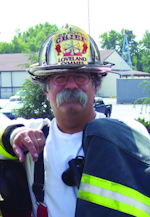
Billy Goldfeder
BILLY GOLDFEDER, EFO, who is a Firehouse contributing editor, has been a firefighter since 1973 and a chief officer since 1982. He is deputy fire chief of the Loveland-Symmes Fire Department in Ohio, which is an ISO Class 1, CPSE and CAAS-accredited department. Goldfeder has served on numerous NFPA and International Association of Fire Chiefs (IAFC) committees. He is on the board of directors of the IAFC Safety, Health and Survival Section and the National Fallen Firefighters Foundation.
